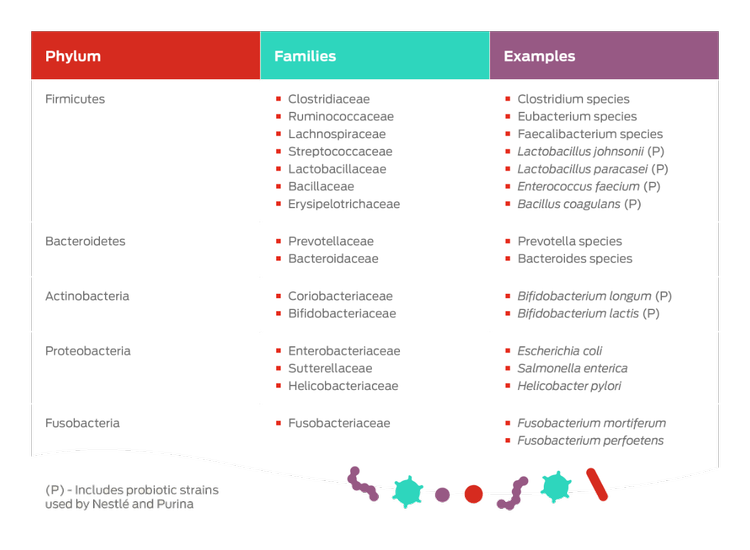
INTESTINAL VILLI WITH BACTERIA
What Comprises The Microbiomes?
The microbiome is the full collection of the microorganisms (the microbiota), their genes, and their microenvironment (habitat) in a specific area. Bacteria comprise approximately 98% of the microbiome.1,2
Subsets of the microbiome include the virome (viruses), mycobiome (fungi) and archaeome (archeae; these organisms resemble bacteria, but are a distinct domain).3 It is a dynamic environment with complex interactions and interconnected metabolisms.4
The virome includes viruses that infect the bacteria (bacteriophages) within the microbiome as well as the host cells in the environment.5,6 Bacteriophages comprise the majority of the virome.5,6 To date, research on the virome is limited6,7 but changes in the fecal virome have been identified in dogs with chronic enteropathy or acute diarrhea.5,6 Similarly, published research on the mycobiome in pets is also limited at this time.8
The genes present in the gut microbiome far outnumber the genes in the host. In humans, it is estimated the microbial genes are more than 100-fold higher.9
Metagenomic analysis of kittens’ gut microbiome showed the number of unique genes identified was approximately 108 times higher than the number of open reading frames identified in the cat genome.10
The most abundant bacterial phyla of the gut microbiome are Firmicutes, Bacteroides and Fusobacteria, followed by Proteobacteria and Actinobacteria.11

The phylum Proteobacteria is the most diverse phylum in the gut microbiome, and includes a number of known opportunistic pathogens - such as Escherichia coli, Klebsiella, Salmonella, and Campylobacter – as well as bacteria that play vital roles in gut homeostasis.12 The feline fecal microbiome may be more diverse than that of the dog.12
Explore other areas of the Microbiome Forum
Find out more
- Barko, P.C., McMichael, M.A., Swanson, K.S., Williams, D.A. (2018). The gastrointestinal microbiome: a review. Journal of Veterinary Internal Medicine, 32, 9–25. doi: 10.1111/jvim.14875
- Marchesi, J. R. & Ravel, J. (2015). The vocabulary of microbiome research: a proposal. Microbiome, 3, 31. doi: 10.1186/s40168-015-0095-5
- Kim, J. Y., Whon, T. W., Lim, M. Y., Kim, Y. B., Kim, N., Kwo, M.-S.,…Na, Y.-D. (2020). The human gut archaeome: identification of diverse haloarchaea in Korean subjects. Microbiome, 8, 114. doi: 10.1186/s40168-020-00894-x
- Seth, E. C., & Taga, M. E. (2014). Nutrient cross-feeding in the microbial world. Frontiers in Microbiology, 5, 350. doi: 10.3389/fmicb.2014.00350
- Moreno, P. S., Wagner, J., Mansfield, C. S., Stevens, M., Gilkerson, J. R., & Kirkwood, C. D. (2017). Characterization of the canine faecal virome in healthy dogs and dogs with acute diarrhoea using shotgun metagenomics. PLoS ONE, 12(6), e0178433. doi: 10.1371/journal.pone.0178433
- Moreno, P. S., Wagner, J., Kirkwood, C. D., Gilkerson, J. R., & Mansfield, C. S. (2018). Characterization of the fecal virome in dogs with chronic enteropathy. Veterinary Microbiology, 221, 38–43. doi: 10.1016/j.vetmic.2018.05.020
- Zhang, W., Li, L., Deng, X., Kapusinszky, B., Pesavento, P. A., Delwart, E. (2014). Faecal virome of cats in an animal shelter. Journal of General Virology, 95, 2553–2564. doi: 10.1099/vir.0.069674-0
- Foster, M. L., Dowd, S. E., Stephenson, C., Steiner, J. M., & Suchodolski, J. S. (2013). Characterization of the fungal microbiome (mycobiome) in fecal samples from dogs. Veterinary Medicine International, 2013, 658373. doi: 10.1155/2013/658373
- Richards, P., Thornberry, N. A., & Pinto, S. (2021). The gut-brain axis: Identification of new therapeutic approaches for Type 2 diabetes, obesity, and related disorders. Molecular Metabolism, E pub ahead of print. doi: 10.1016/j.molmet.2021.101175
- Deusch, O., O’Flynn, C., Colyer, A., Morris, P., Allaway, D., Jones, P. G., & Swanson, K. S. (2014). Deep Illumina-based shotgun sequencing reveals dietary effects on the structure and function of the fecal microbiome of growing kittens. PLoS ONE, 9(7), e101021. doi: 10.1371/ journal.pone.0101021
- Suchodolski, J. S. (2011). The intestinal microbiota of dogs and cats: A bigger world than we thought. Veterinary Clinics of North America Small Animal Practice, 41, 261–272. doi: 10.1016/j.cvsm.2010.12.006
- Belas, A., Marques, C., & Pomba, C. (2020). The gut microbiome and antimicrobial resistance in companion animals. In Duarte, A. & Lopes da Costa, L. (Eds.), Advances in Animal Health, Medicine and Production (1st ed.), pp. 233–245. Springer International Publishing

